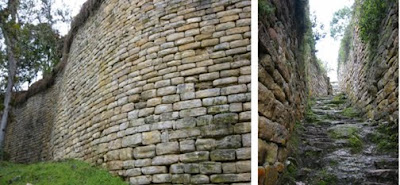As early as the time of Nephi, “he having been a great protector for them, having wielded the sword of Laban in their defense” (Jacob 1:10) around 570 B.C., and as late as Mormon in 385 A.D., “I, Mormon, began to be old; and knowing it to be the last struggle of my people” (Mormon 6:6). Throughout the intervening centuries, these wars raged, with only occasional respites of peace that sometimes lasted a year or two (Alma 1:28), except for the 200 years of peace after the coming of the Savior (4 Nephi 1:22).
 Moroni was a genius at building defenses to stop the Lamanites. Around the Nephite cities he had walls built, and these walls were sufficiently high, strong, and wide at the top for him to stand upon (Alma 62:20) and for Samuel the Lamanite to preach while upon a city wall (Helaman 13:2). He also built forts of security for every city in all the land round about” (Alma 49:13).
Moroni was a genius at building defenses to stop the Lamanites. Around the Nephite cities he had walls built, and these walls were sufficiently high, strong, and wide at the top for him to stand upon (Alma 62:20) and for Samuel the Lamanite to preach while upon a city wall (Helaman 13:2). He also built forts of security for every city in all the land round about” (Alma 49:13).Moroni’s Lieutenant, Teancum, also built walls: “he kept his men round about, as if making preparations for war; yea, and truly he was preparing to defend himself against them, by casting up walls round about and preparing places of resort” (Alma 52:5-6). These were walls of rock, timber and earth. “The Nephites had dug up a ridge of earth round about them, which was so high that the Lamanites could not cast their stones and their arrows at them that they might take effect, neither could they come upon them save it was by their place of entrance” (Alma 49:4), and “Now behold, the Lamanites could not get into their forts of security by any other way save by the entrance, because of the highness of the bank which had been thrown up, and the depth of the ditch which had been dug round about, save it were by the entrance” (Alma 49:18). For timbers, “they did cause the Lamanites to labor until they had encircled the city of Bountiful round about with a strong wall of timbers and earth, to an exceeding height” (Alma 53:4).
In fact, “many cities…were strongly fortified after the manner of the fortifications of Moroni; all of which afforded strongholds for the Lamanites” (Alma 51:27). Moroni, and later his son, were constantly building defenses for their lands and cities. “When he had fortified the city Gid” (Alma 55:26), and “had, by their labors, fortified the city Morianton until it had become an exceeding stronghold” (Alma 55:33), and “Moroni had fortified those parts of the land which were most exposed to the Lamanites, until they were sufficiently strong” (Alma 62:42).
In all these cases, with the Nephites fortifying cities with defensive walls about them, for the purpose of keeping the Lamanites from attacking, or at least from gaining access to their cities, we would expect to find whatever ruins the Nephites left behind to be structures built for defense. However, in the case of Mesoamerica, just about all their impressive edifices lacked any defensive nature, there were no walled cities, and their pyramids, temples, palaces, and other buildings, were built out in the open.
 On the other hand, in the Andean area of South America, these same type buildings were erected as fortifications, including small resorts (forts) round about, and walled cities, defensive walls, and other obvious signs that the people who inhabited that land in B.C. times, had their defense in mind.
On the other hand, in the Andean area of South America, these same type buildings were erected as fortifications, including small resorts (forts) round about, and walled cities, defensive walls, and other obvious signs that the people who inhabited that land in B.C. times, had their defense in mind. The fortress of Kulap, with a walled city occupying the top of a plateau, and with two entrances up narrow alleys wide enough for only one person at a time and from which missiles, arrows and spears could be flung down upon an invading force.
The fortress of Kulap, with a walled city occupying the top of a plateau, and with two entrances up narrow alleys wide enough for only one person at a time and from which missiles, arrows and spears could be flung down upon an invading force. In addition, there are small resorts (forts) scattered around the Andean area that guard passes, canyons, and river entrances to major ancient city areas. There is also the Great Wall of Peru (see earlier posts) that covers from the coast to several miles inland built to keep those in the south from gaining entrance to the north.
In addition, there are small resorts (forts) scattered around the Andean area that guard passes, canyons, and river entrances to major ancient city areas. There is also the Great Wall of Peru (see earlier posts) that covers from the coast to several miles inland built to keep those in the south from gaining entrance to the north. All of these Andean ruins have outer walls and layered defenses
All of these Andean ruins have outer walls and layered defenses




No comments:
Post a Comment